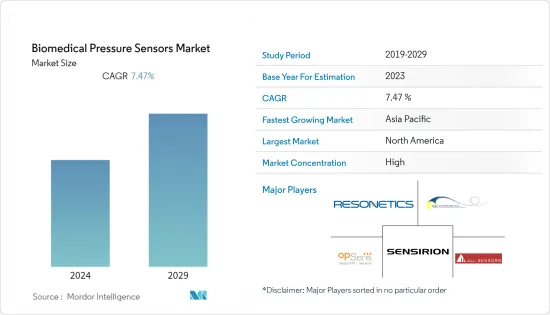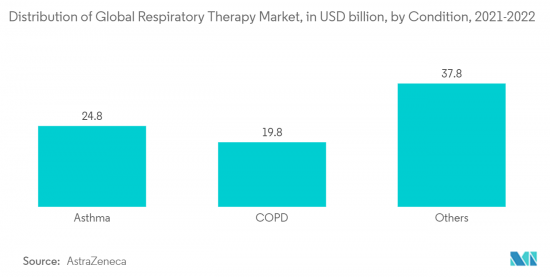PUBLISHER: Mordor Intelligence | PRODUCT CODE: 1403076

PUBLISHER: Mordor Intelligence | PRODUCT CODE: 1403076
Biomedical Pressure Sensors - Market Share Analysis, Industry Trends & Statistics, Growth Forecasts 2024 - 2029

The biomedical pressure sensors market was valued at USD 974.81 billion the previous year and is expected to grow at a CAGR of 7.47%, reaching USD 1.473 trillion over the forecast period.
Key Highlights
- Biomedical pressure sensors are special electronic devices that may transduce pressure signals into measurable electric signals. These sensors are the critical component in various medical diagnostic and therapeutic equipment and instruments. Over the years, sensor technology has evolved significantly, leading to the incorporation of these sensors in advanced medical devices. Moreover, this has also facilitated the development of miniaturized and portable yet effective medical devices.
- Biomedical pressure sensors may monitor a patient's condition by providing reliable diagnostics in a broad range of conditions. This may include monitoring oxygen therapy effectiveness in oxygen concentrators, automating drug infusion by administering the correct volume and rate of fluid in infusion pumps, or even measuring blood pressure.
- A significant factor driving the growth of the market studied is the growing demand for enhanced patient care, which results from growing consumer awareness and increasing healthcare expenditure globally. For instance, according to the Organisation for Economic Co-operation and Development (OECD), in 2022, the United States (16.6%) was the leading country in terms of healthcare expenditure as a percentage of GDP, followed by countries such as Germany (12.7%), France (11.9%), and Japan (11.5%), among others.
- As higher healthcare expenditure positively influences investments in advanced medical devices and medical infrastructure wherein pressure sensors widely find their application, the growing healthcare expenditure is anticipated to positively influence the studied market's growth.
- However, the technical limitations of biomedical pressure sensors, such as the environmental influence on the detection capabilities and reading of the sensor, remain among the major restraining factors for the studied market's growth. Additionally, the need for product differentiation and awareness, especially in the developing regions, as well as the cost of the sensors, also challenges the studied market's growth.
- The global outbreak of COVID-19 had a major impact on the growth of the studied market as the demand for advanced medical devices, especially in the portable and personal use segment, grew significantly. Such trends, despite issues such as supply chain disruptions, held the market demand for biomedical pressure sensors intact. The post-COVID-19 period also appears promising for the studied market as the pandemic highlighted the shortcomings of the healthcare industry globally, driving the attention of the industry stakeholders, which is expected to drive investments in the healthcare industry, creating opportunities in the market studied.
Biomedical Pressure Sensors Market Trends
Therapeutic Applications to Witness Major Growth
- Several therapeutic devices, such as chest physiotherapy machines and nebulizers, use pressure sensors. A nebulizer uses compressed air to create a mist of medication the patient inhales. A pressure sensor measures the compressed air flow rate and adjusts accordingly to ensure accurate drug delivery. These machines are designed to treat chronic obstructive pulmonary disease (COPD), asthma, cystic fibrosis, asthma, and other respiratory disorders.
- Chest physiotherapy machines use jets of high-pressure air to loosen phlegm and phlegm from the lungs. A pressure sensor in these devices monitors the pressure of the jet and adjusts the pressure accordingly for optimal therapeutic effect.
- Respiratory physiotherapy equipment offers many advantages, such as independent application, complete control of treatment, and ease of use, thus helping to improve patient compliance in daily treatment, thus increasing the demand for respiratory physiotherapy equipment.
- Furthermore, the growing demand for innovative respiratory drug delivery devices and the increasing adoption of these devices among the patient population will propel the demand for biomedical pressure sensors in therapeutic applications.
- The increasing incidence of respiratory diseases such as asthma and COPD is creating a high demand for therapeutic devices, further supporting the market growth. As per the AstraZeneca Annual Report, the global asthma therapy market generated USD 24.8 billion. According to the Global Asthma Report 2022, 1 in 10 children have asthma symptoms. Globally, asthma is the 24th leading cause of years lived with disability and the 34th leading cause of the burden of disease, as measured by disability-adjusted life years (DALYs). More than 1,000 people die every day from asthma. Low- and middle-income countries suffer disproportionately from the worst cases.
- Moreover, the growing adoption of portable therapeutic devices has increased the demand for pressure sensors. For instance, airflow rates, which are typically expressed in liters per minute, can be calculated by measuring pressure and using known fluid dynamic principles.

Asia-Pacific is Expected to Register Significant Growth
- The major share in the Asia-Pacific region can be attributed to the growth in application areas of the healthcare sector. It is predicted that the escalating demand in emerging economies, such as China, South Korea, and India, will greatly contribute to the rising demand for biomedical pressure sensors.
- The Asia-Pacific segment is expected to witness high growth during the forecast period. Major factors supporting the growth include investments in medical infrastructure, research and innovation centers, government programs, and policies favoring the healthcare equipment and devices markets.
- The market is driven by an increase in government initiatives in mHealth products, a rise in the adoption of smartphones and other electronic devices with sensor technology, a surge in investment by public and private players to introduce sensors in mHealth, and an increase in adoption of Internet of Things (IoT) and advanced technologies.
- The Asia-Pacific market is anticipated to experience growth, owing to factors such as the increasing prevalence of chronic disorders and the rising awareness of medical sensors among individuals. The growth of the biomedical pressure sensors market in these regions is attributed to the increased emphasis on the development of medical sensors in recent years, the enhancement of healthcare infrastructure, and the early detection of diseases.
- The rising government investments in China will boost the country's medical device market, further creating lucrative growth opportunities for the market studied. For instance, in September 2022, the Government of China announced a loan incentive policy of CNY 1.70 trillion (USD 246.40 billion) to encourage medical facilities, universities, and public buildings to upgrade their medical equipment.
Biomedical Pressure Sensors Industry Overview
The sensor industry is anticipated to face significant competitive challenges during the forecast period due to the limited number of manufacturers. Market leaders, including Resonetics LLC, RJC Enterprises LLC, All Sensors Corporation, and Opsens Inc., among others, exert considerable influence on the overall market. These companies have expanded their operations by focusing on market expansion and acquisitions. However, their ability to develop products that align with market demands has been limited, resulting in fewer new product launches and technological upgrades, which in turn affects the overall growth of the sensor sector. In terms of sustainable competitive advantage through innovation, the sensor market needs to catch up to other industries due to the relatively small number of players developing biomedical pressure sensors, resulting in a moderately consolidated market.
In August 2023, LCSC announced a collaboration with Sensirion aimed at providing enhanced solutions to customers through Sensirion's high-quality products. This partnership is expected to expand LCSC's customer base and solidify its position in the market.
In April 2023, Superior Sensor Technology introduced biomedical pressure sensors specifically designed for medical ventilators. These sensors incorporate over-sampling techniques to significantly enhance their dynamic range. This improvement enables mechanical ventilators to directly utilize sensor outputs without the need for post-sensor over-sampling processes.
Additional Benefits:
- The market estimate (ME) sheet in Excel format
- 3 months of analyst support
TABLE OF CONTENTS
1 INTRODUCTION
- 1.1 Study Assumptions and Market Definition
- 1.2 Scope of the Study
2 RESEARCH METHODOLOGY
3 EXECUTIVE SUMMARY
4 MARKET INSIGHTS
- 4.1 Market Overview
- 4.2 Industry Attractiveness - Porter's Five Forces Analysis
- 4.2.1 Bargaining Power of Suppliers
- 4.2.2 Bargaining Power of Buyers
- 4.2.3 Threat of New Entrants
- 4.2.4 Threat of Substitutes
- 4.2.5 Degree of Competition
- 4.3 Overview of Pressure Mapping Systems
5 MARKET DYNAMICS
- 5.1 Market Drivers
- 5.1.1 Growing Demand for Low-cost, High Performance, and Reliable Sensors
- 5.1.2 Demand for Enhanced Patient Care
- 5.2 Market Restraints
- 5.2.1 Environmental Impact on Sensors
- 5.2.2 Lack of Product Differentiation
6 MARKET SEGMENTATION
- 6.1 By Technology
- 6.1.1 Self-calibrating
- 6.1.2 Fiber-optic
- 6.1.3 Telemetric
- 6.1.4 Capacitive
- 6.1.5 Wireless Passive
- 6.1.6 Piezoresistive
- 6.2 By Application
- 6.2.1 Diagnostic
- 6.2.2 Therapeutic
- 6.2.3 Medical Imaging
- 6.2.4 Monitoring
- 6.2.5 Fitness and Wellness
- 6.2.6 Other Applications
- 6.3 By Geography
- 6.3.1 North America
- 6.3.2 Europe
- 6.3.3 Asia Pacific
- 6.3.4 Latin America
- 6.3.5 Middle East and Africa
7 COMPETITIVE LANDSCAPE
- 7.1 Company Profiles
- 7.1.1 Resonetics LLC
- 7.1.2 RJC Entreprises LLC
- 7.1.3 All Sensors Corporation (Amphenol Corporation)
- 7.1.4 Opsens Inc.
- 7.1.5 Sensirion Holding AG
- 7.1.6 Merit Medical Systems Inc.
8 INVESTMENT ANALYSIS
9 FUTURE OF THE MARKET




